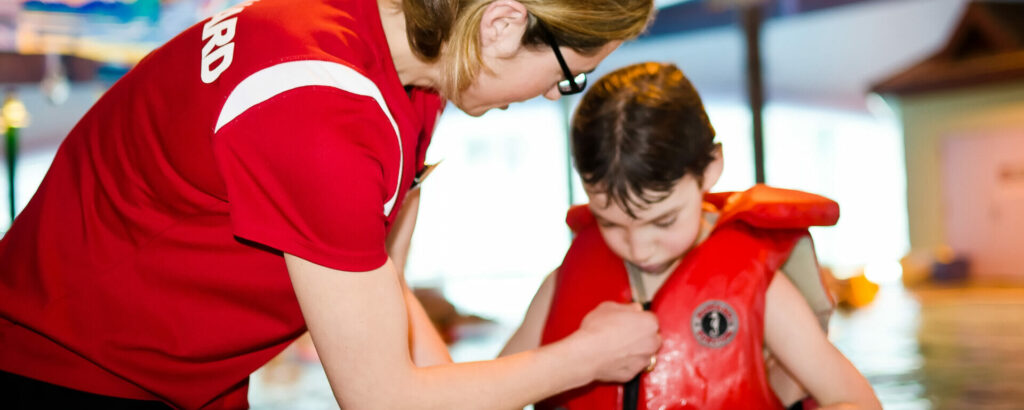Meadow Park Sports Centre offers swimming lessons for all ages and abilities, as well as nationally recognized lifeguard training and swim instructor certifications.
Winter registration dates
- Resident online registration – Saturday, December 6 at 11 a.m.
- Resident phone registration – Sunday, December 7 at 9 a.m.
- Non-resident online registration – Saturday, December 13 at 11 a.m.
- Non-resident phone registration – Sunday, December 14 at 9 a.m.

New for 2025: swim lesson prerequisite and level checks
To ensure proper placement in swim programs, our registration system automatically now verifies all required prerequisites. This helps every child start their swimming journey with confidence.
How to check prerequisites: Parents can review their child’s prerequisites through the “Activity Outcomes” tab in their family profile at MyRecreation.
Important: Age prerequisites still apply to all swimming lessons.
Free swim assessments available
If you want to enroll in a swim program and aren’t sure of the correct level, visit Meadow Park Sports Centre pool to request a complimentary swim assessment.
Assessment process:
- Visit MPSC during operating hours and speak to the front desk.
- A lifeguard will conduct the assessment. Children under the age of 7 must have a parent in the water with them.
- Bring a recent report card from another facility if available.
- Complete assessments one week before registration day for processing.
- Regular drop-in fees apply if you choose to swim after the assessment.
Recertifications & clinics
Royal Life Saving Society Commonwealth Lifeguard Transfer Course
The RLSS Commonwealth Lifeguard Transfer Program recognizes that lifeguards from the United Kingdom, Australia, and South Africa receive training similar to that in Canada in their home countries. The program builds on that foundation and focuses on training candidates in the specific skills needed to work as a lifeguard in Canada, thus significantly reducing training time and helping lifeguards get on deck sooner.
Certification check: contact the Lifesaving Society of British Columbia to check your certification eligibility.
Prerequisites: Standard First Aid
To register: visit our registration page.
For more information: mlaxandujar@whistler.ca or 604-935-8357.
Swimming lessons
Parent & tot lessons (ages 4-36 months)
The Lifesaving Society Parent & Tot program helps introduce children to the water through play-based activities. For more details on each program and registration, click here.
- Parent & Tot 1 – Jellyfish (4-12 months)
- Babies must be able to hold their head up
- Focus on buoyancy, movement, and water safety
- Parent & Tot 2 – Goldfish (12-24 months)
- Learn floating, water movement, and basic safety
- Fun games, songs, and interactive play
- Parent & Tot 3 – Seahorse (24-36 months)
- Introduction to gliding, floating, and kicking with support
- Parent participation is encouraged
Preschool lessons (Ages 3-5)
Children new to lessons should register for Preschool 1 – Octopus.
Detailed descriptions and registration is available here.
- Preschool 1 – Octopus: Water entry, floating, and blowing bubbles
- Preschool 2 – Crab: Jumping in, lifejacket use, and gliding
- Preschool 3 – Orca: Deep water entries, object retrieval, and kicking
- Preschool 4 – Sea Lion: Sideways entries, 5m swimming, and water skills
- Preschool 5 – Narwhal: Treading water, front/back crawl, and whip kick
Age group swim lessons (Ages 5-12)
Designed for all skill levels, these lessons build confidence and technique.
- Swimmer 1: Water comfort, floating, and kicking
- Swimmer 2: Deep water jumps, whip kick, and 10 m swimming
- Swimmer 3: Handstands, somersaults, and 15 m swimming
- Swimmer 4: Underwater swimming, stroke endurance, and 25 m sprints
- Swimmer 5: Advanced diving, stroke refinement, and interval training
- Swimmer 6: Lifesaving kicks, 300 m endurance workouts
- Swimmer 7 – Rookie: 50 m strokes, rescue skills, and first aid basics
- Swimmer 8 – Ranger: Timed object rescues, shock treatment, and lifesaving drills
- Swimmer 9 – Star: Advanced lifeguarding, 600 m workouts, and victim rescues
For more information on each level, as well as to register for classes, click here.
Adult swim lessons
- Adult 1: Water confidence, floating, and basic stroke work
- Adult 2: 25m interval training, dive entries, and endurance
- Adult 3: Stroke mastery, 300 m endurance swims, and lifesaving skills
Registration and details on adult swimming programs can be found here.
Aquatic leadership programs
Lifeguard & instructor training
Becoming a certified lifeguard or swim instructor in British Columbia requires the following courses:
- Bronze Medallion (Age 13+ or Bronze Star required)
- Lifesaving principles, rescue techniques, and 400 m timed swims
- Includes CPR-A certification
- Bronze Cross (Prerequisite: Bronze Medallion)
- Spinal injury management, fitness training, and CPR-C certification
- Earns 2 high school credits (Grade 11)
- Swim for Life – Swim Instructor Certification
- Required to teach preschool and age group lessons
- Must hold Bronze Cross
- Standard First Aid & CPR (Age 12+)
- Covers emergency response, injury treatment, and AED use
- Recognized for National Lifeguard certification.
- National Lifeguard Certification (Age 15+)
- Prerequisites: SFA/CPR, Bronze Cross
- Earns 2 high school credits (Grade 12)
- Lifesaving Instructor (Age 15+)
- Prerequisite: Bronze Cross
- Earns 1 high school credit (Grade 11)
- Trains candidates to teach lifeguarding and first aid skills
Click here for more details and registration.